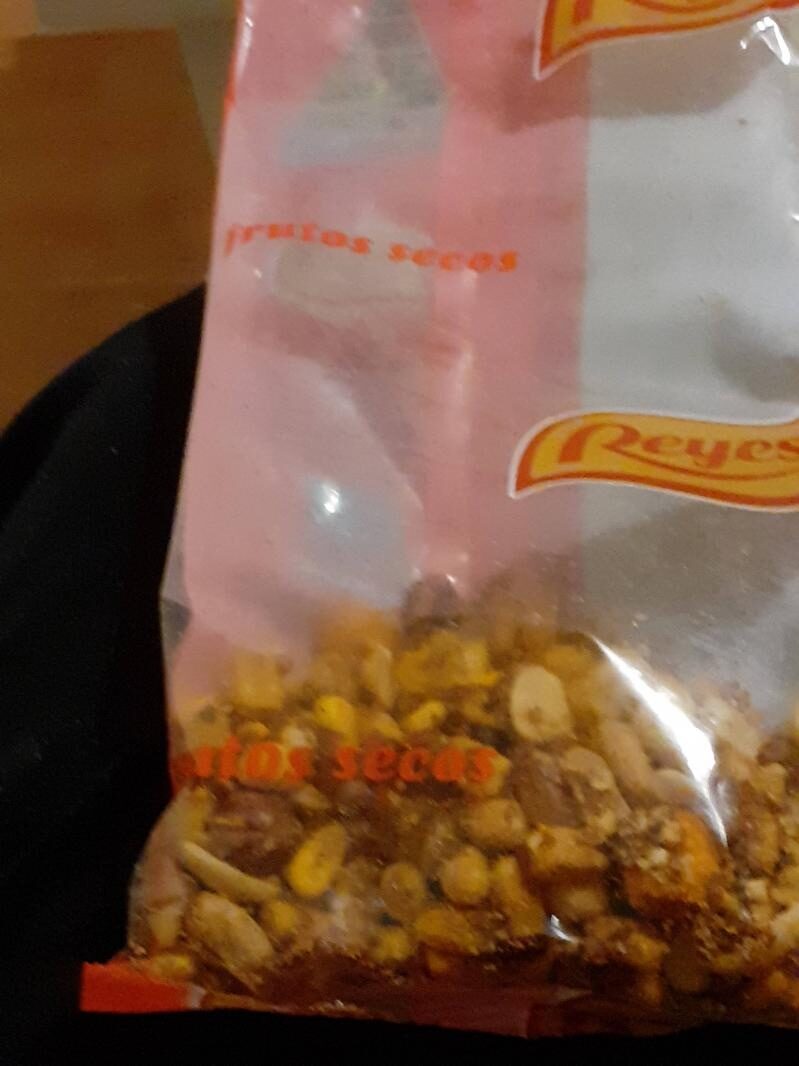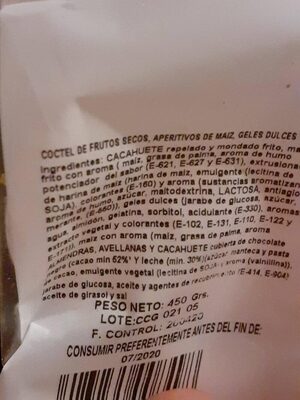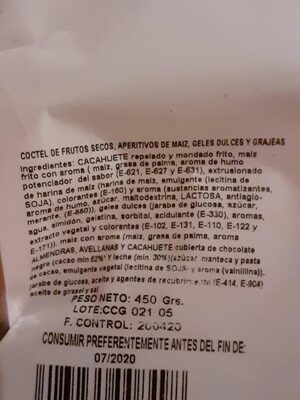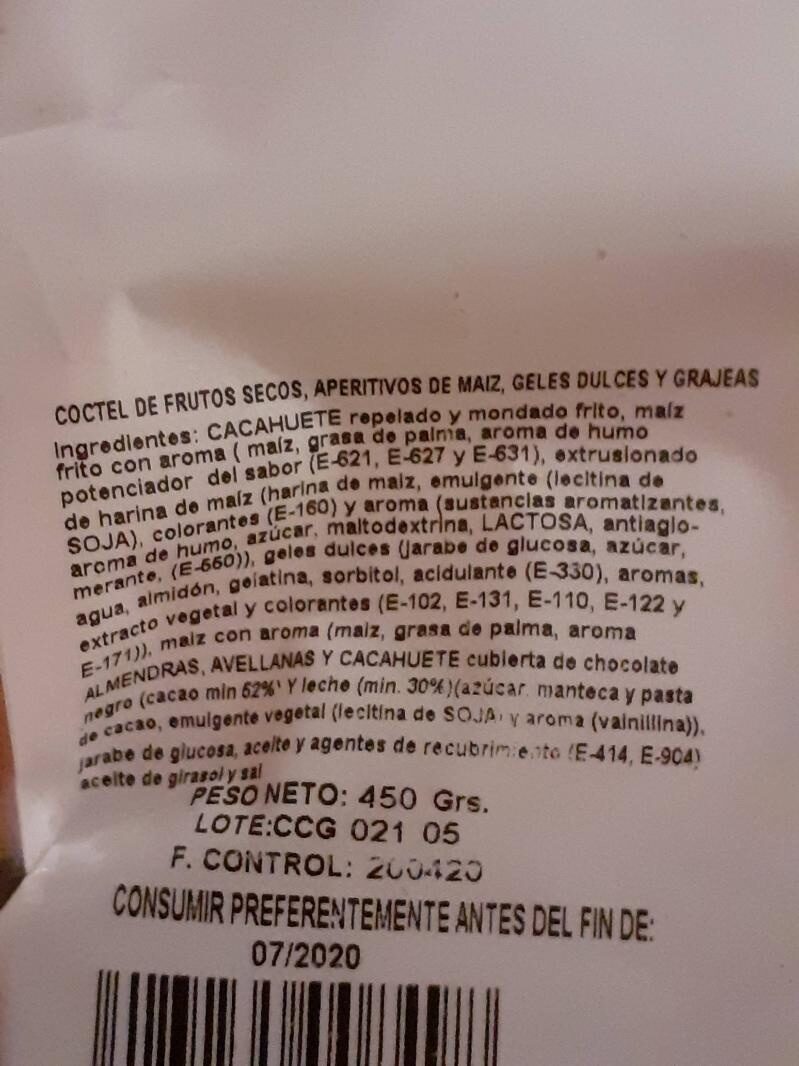Ajuda'ns a fer que la transparència alimentària sigui la norma!
Com a organització sense ànim de lucre, depenem de les vostres donacions per continuar informant els consumidors de tot el món sobre tot allò què mengen.
La revolució alimentària comença amb tu!
8423235008498
8423235008498
Aquesta pàgina del producte no està completa. Podeu ajudar a completar-la editant-la i afegint-hi més dades a partir de les fotos ja disponibles, o fent-ne més amb l'aplicació de androide o iPhone / iPad. Gràcies!
×
Codi de barres: 8423235008498 (EAN / EAN-13)
Països on es va vendre: Espanya
Matching with your preferences
Salut
Ingredients
-
58 ingredients
: CACAHUETE repelado y mondado frito, ma frito con aroma (malz, grasa de paina, aroma de humo potenciador del sabor (E-621, E-627 y E-631), extrusiona - de harina de maiz (harina de maiz, emulgente (lecitina de SOJA), colorantes (E-160) y aroma (sustancias aromatizan aroma de humo, azúcar, maltodextrina, LACTOSA, antiagio merante, (E-660)), geles dulces (jarabe de glucosa, azúcar, agua, almidón, gelatina, sorbitol, acidulante (E-330), aromas extracto vegetal y colorantes (E-102, E-131, E-110, E-122 y ALMENDRAS, AVELLANAS Y CACAHUETE cubierta de chocolate E-171)), maiz con aroma (maiz, grasa de palma, aroma negro (cacao min 62%' Y leche (min, 30%)(azúcar manteca y pasta , emulgente vegetal (lecitina de SOJAV aroma ( de glucosa, aceite y agentes de recubrimento (E-414, E-904) (vainillina)), de cacao, Jarabe aceite de girasol y sal PESO NETO: 450 Grs, 021 05 LOTE:CCG F, CONTROL: 200420Al·lèrgens: en:Milk, en:Nuts, en:Peanuts, en:Soybeans
Processament d'aliments
-
Aliments ultra processats
Elements que indiquen que el producte està al grup 4 - Aliments i begudes ultraprocessats:
- Additiu: E102 - Tartrazina
- Additiu: E110 - Groc ataronjat S
- Additiu: E122 - Azorrubina
- Additiu: E131 - Blau patentat V
- Additiu: E160 - Carotenoides
- Additiu: E322 - Lecitines
- Additiu: E414 - Goma aràbiga
- Additiu: E420 - Sorbitol
- Additiu: E428 - Gelatina
- Additiu: E621 - Glutamat de monosodi
- Additiu: E627 - Guanilat de disodi
- Additiu: E631 - Inosinat de disodi
- Additiu: E904 - Goma laca
- Ingredient: Color
- Ingredient: Emulsionant
- Ingredient: Aromes
- Ingredient: Glucosa
- Ingredient: Xarop de glucosa
- Ingredient: Lactosa
- Ingredient: Maltodextrina
Els productes alimentaris es classifiquen en 4 grups segons el seu grau de processament:
- Aliments no processats o mínimament processats
- Ingredients culinaris processats
- Aliments processats
- Aliments ultra processats
La determinació del grup es fa en funció de la categoria del producte i dels ingredients que conté.
Additius
-
E102 - Tartrazina
Tartrazine: Tartrazine is a synthetic lemon yellow azo dye primarily used as a food coloring. It is also known as E number E102, C.I. 19140, FD&C Yellow 5, Acid Yellow 23, Food Yellow 4, and trisodium 1--4-sulfonatophenyl--4--4-sulfonatophenylazo--5-pyrazolone-3-carboxylate-.Tartrazine is a commonly used color all over the world, mainly for yellow, and can also be used with Brilliant Blue FCF -FD&C Blue 1, E133- or Green S -E142- to produce various green shades.Origen: Wikipedia (Anglès)
-
E110 - Groc ataronjat S
Sunset Yellow FCF: Sunset Yellow FCF -also known as Orange Yellow S, or C.I. 15985- is a petroleum-derived orange azo dye with a pH dependent maximum absorption at about 480 nm at pH 1 and 443 nm at pH 13 with a shoulder at 500 nm. When added to foods sold in the US it is known as FD&C Yellow 6; when sold in Europe, it is denoted by E Number E110.Origen: Wikipedia (Anglès)
-
E122 - Azorrubina
Azorubine: Azorubine is an azo dye produced as a disodium salt. In its dry form, the product appears red to maroon. It is mainly used in foods which are heat-treated after fermentation. It has E number E122.Origen: Wikipedia (Anglès)
-
E131 - Blau patentat V
Patent Blue V: Patent Blue V, also called Food Blue 5, Sulphan Blue, Acid Blue 3, L-Blau 3, C-Blau 20, Patentblau V, Sky Blue, or C.I. 42051 and is a dark bluish synthetic triphenylmethane dye used as a food coloring. As a food additive, it has E number E131. It is a sodium or calcium salt of [4--α--4-diethylaminophenyl--5-hydroxy- 2‚4-disulfophenylmethylidene--2‚5-cyclohexadien-1-ylidene] diethylammonium hydroxide inner salt.Origen: Wikipedia (Anglès)
-
E322 - Lecitines
Lecithin: Lecithin -UK: , US: , from the Greek lekithos, "egg yolk"- is a generic term to designate any group of yellow-brownish fatty substances occurring in animal and plant tissues, which are amphiphilic – they attract both water and fatty substances -and so are both hydrophilic and lipophilic-, and are used for smoothing food textures, dissolving powders -emulsifying-, homogenizing liquid mixtures, and repelling sticking materials.Lecithins are mixtures of glycerophospholipids including phosphatidylcholine, phosphatidylethanolamine, phosphatidylinositol, phosphatidylserine, and phosphatidic acid.Lecithin was first isolated in 1845 by the French chemist and pharmacist Theodore Gobley. In 1850, he named the phosphatidylcholine lécithine. Gobley originally isolated lecithin from egg yolk—λέκιθος lekithos is "egg yolk" in Ancient Greek—and established the complete chemical formula of phosphatidylcholine in 1874; in between, he had demonstrated the presence of lecithin in a variety of biological matters, including venous blood, in human lungs, bile, human brain tissue, fish eggs, fish roe, and chicken and sheep brain. Lecithin can easily be extracted chemically using solvents such as hexane, ethanol, acetone, petroleum ether, benzene, etc., or extraction can be done mechanically. It is usually available from sources such as soybeans, eggs, milk, marine sources, rapeseed, cottonseed, and sunflower. It has low solubility in water, but is an excellent emulsifier. In aqueous solution, its phospholipids can form either liposomes, bilayer sheets, micelles, or lamellar structures, depending on hydration and temperature. This results in a type of surfactant that usually is classified as amphipathic. Lecithin is sold as a food additive and dietary supplement. In cooking, it is sometimes used as an emulsifier and to prevent sticking, for example in nonstick cooking spray.Origen: Wikipedia (Anglès)
-
E322i - Lecitina
Lecithin: Lecithin -UK: , US: , from the Greek lekithos, "egg yolk"- is a generic term to designate any group of yellow-brownish fatty substances occurring in animal and plant tissues, which are amphiphilic – they attract both water and fatty substances -and so are both hydrophilic and lipophilic-, and are used for smoothing food textures, dissolving powders -emulsifying-, homogenizing liquid mixtures, and repelling sticking materials.Lecithins are mixtures of glycerophospholipids including phosphatidylcholine, phosphatidylethanolamine, phosphatidylinositol, phosphatidylserine, and phosphatidic acid.Lecithin was first isolated in 1845 by the French chemist and pharmacist Theodore Gobley. In 1850, he named the phosphatidylcholine lécithine. Gobley originally isolated lecithin from egg yolk—λέκιθος lekithos is "egg yolk" in Ancient Greek—and established the complete chemical formula of phosphatidylcholine in 1874; in between, he had demonstrated the presence of lecithin in a variety of biological matters, including venous blood, in human lungs, bile, human brain tissue, fish eggs, fish roe, and chicken and sheep brain. Lecithin can easily be extracted chemically using solvents such as hexane, ethanol, acetone, petroleum ether, benzene, etc., or extraction can be done mechanically. It is usually available from sources such as soybeans, eggs, milk, marine sources, rapeseed, cottonseed, and sunflower. It has low solubility in water, but is an excellent emulsifier. In aqueous solution, its phospholipids can form either liposomes, bilayer sheets, micelles, or lamellar structures, depending on hydration and temperature. This results in a type of surfactant that usually is classified as amphipathic. Lecithin is sold as a food additive and dietary supplement. In cooking, it is sometimes used as an emulsifier and to prevent sticking, for example in nonstick cooking spray.Origen: Wikipedia (Anglès)
-
E330 - Acid citric
Citric acid: Citric acid is a weak organic acid that has the chemical formula C6H8O7. It occurs naturally in citrus fruits. In biochemistry, it is an intermediate in the citric acid cycle, which occurs in the metabolism of all aerobic organisms. More than a million tons of citric acid are manufactured every year. It is used widely as an acidifier, as a flavoring and chelating agent.A citrate is a derivative of citric acid; that is, the salts, esters, and the polyatomic anion found in solution. An example of the former, a salt is trisodium citrate; an ester is triethyl citrate. When part of a salt, the formula of the citrate ion is written as C6H5O3−7 or C3H5O-COO-3−3.Origen: Wikipedia (Anglès)
-
E414 - Goma aràbiga
Gum arabic: Gum arabic, also known as acacia gum, arabic gum, gum acacia, acacia, Senegal gum and Indian gum, and by other names, is a natural gum consisting of the hardened sap of various species of the acacia tree. Originally, gum arabic was collected from Acacia nilotica which was called the "gum arabic tree"; in the present day, gum arabic is collected from acacia species, predominantly Acacia senegal and Vachellia -Acacia- seyal; the term "gum arabic" does not indicate a particular botanical source. In a few cases so‐called "gum arabic" may not even have been collected from Acacia species, but may originate from Combretum, Albizia or some other genus. Producers harvest the gum commercially from wild trees, mostly in Sudan -80%- and throughout the Sahel, from Senegal to Somalia—though it is historically cultivated in Arabia and West Asia. Gum arabic is a complex mixture of glycoproteins and polysaccharides. It is the original source of the sugars arabinose and ribose, both of which were first discovered and isolated from it, and are named after it. Gum arabic is soluble in water. It is edible, and used primarily in the food industry as a stabilizer, with EU E number E414. Gum arabic is a key ingredient in traditional lithography and is used in printing, paint production, glue, cosmetics and various industrial applications, including viscosity control in inks and in textile industries, though less expensive materials compete with it for many of these roles. While gum arabic is now produced throughout the African Sahel, it is still harvested and used in the Middle East.Origen: Wikipedia (Anglès)
-
E420 - Sorbitol
Sorbitol: Sorbitol --, less commonly known as glucitol --, is a sugar alcohol with a sweet taste which the human body metabolizes slowly. It can be obtained by reduction of glucose, which changes the aldehyde group to a hydroxyl group. Most sorbitol is made from corn syrup, but it is also found in nature, for example in apples, pears, peaches, and prunes. It is converted to fructose by sorbitol-6-phosphate 2-dehydrogenase. Sorbitol is an isomer of mannitol, another sugar alcohol; the two differ only in the orientation of the hydroxyl group on carbon 2. While similar, the two sugar alcohols have very different sources in nature, melting points, and uses.Origen: Wikipedia (Anglès)
-
E621 - Glutamat de monosodi
Monosodium glutamate: Monosodium glutamate -MSG, also known as sodium glutamate- is the sodium salt of glutamic acid, one of the most abundant naturally occurring non-essential amino acids. Glutamic acid is found naturally in tomatoes, grapes, cheese, mushrooms and other foods.MSG is used in the food industry as a flavor enhancer with an umami taste that intensifies the meaty, savory flavor of food, as naturally occurring glutamate does in foods such as stews and meat soups. It was first prepared in 1908 by Japanese biochemist Kikunae Ikeda, who was trying to isolate and duplicate the savory taste of kombu, an edible seaweed used as a base for many Japanese soups. MSG as a flavor enhancer balances, blends, and rounds the perception of other tastes.The U.S. Food and Drug Administration has given MSG its generally recognized as safe -GRAS- designation. A popular belief is that large doses of MSG can cause headaches and other feelings of discomfort, known as "Chinese restaurant syndrome," but double-blind tests fail to find evidence of such a reaction. The European Union classifies it as a food additive permitted in certain foods and subject to quantitative limits. MSG has the HS code 29224220 and the E number E621.Origen: Wikipedia (Anglès)
-
E627 - Guanilat de disodi
Disodium guanylate: Disodium guanylate, also known as sodium 5'-guanylate and disodium 5'-guanylate, is a natural sodium salt of the flavor enhancing nucleotide guanosine monophosphate -GMP-. Disodium guanylate is a food additive with the E number E627. It is commonly used in conjunction with glutamic acid. As it is a fairly expensive additive, it is not used independently of glutamic acid; if disodium guanylate is present in a list of ingredients but MSG does not appear to be, it is likely that glutamic acid is provided as part of another ingredient such as a processed soy protein complex. It is often added to foods in conjunction with disodium inosinate; the combination is known as disodium 5'-ribonucleotides. Disodium guanylate is produced from dried seaweed and is often added to instant noodles, potato chips and other snacks, savory rice, tinned vegetables, cured meats, and packaged soup.Origen: Wikipedia (Anglès)
-
E631 - Inosinat de disodi
Disodium inosinate: Disodium inosinate -E631- is the disodium salt of inosinic acid with the chemical formula C10H11N4Na2O8P. It is used as a food additive and often found in instant noodles, potato chips, and a variety of other snacks. Although it can be obtained from bacterial fermentation of sugars, it is often commercially prepared from animal sources.Origen: Wikipedia (Anglès)
-
E904 - Goma laca
Shellac: Shellac is a resin secreted by the female lac bug, on trees in the forests of India and Thailand. It is processed and sold as dry flakes -pictured- and dissolved in alcohol to make liquid shellac, which is used as a brush-on colorant, food glaze and wood finish. Shellac functions as a tough natural primer, sanding sealant, tannin-blocker, odour-blocker, stain, and high-gloss varnish. Shellac was once used in electrical applications as it possesses good insulation qualities and it seals out moisture. Phonograph and 78 rpm gramophone records were made of it until they were replaced by vinyl long-playing records from the 1950s onwards. From the time it replaced oil and wax finishes in the 19th century, shellac was one of the dominant wood finishes in the western world until it was largely replaced by nitrocellulose lacquer in the 1920s and 1930s.Origen: Wikipedia (Anglès)
Anàlisi dels ingredients
-
Oli de palma
Ingredients que contenen oli de palma: Greix de palma
-
No és vegà
Ingredients no vegans: Lactosa, E428, E904Alguns ingredients no s'han pogut reconèixer.
Necessitem la teva ajuda!
Podeu ajudar-nos a reconèixer més ingredients i analitzar millor la llista d'ingredients d'aquest producte i d'altres mitjançant:
- Editeu aquesta pàgina de producte per corregir les faltes d’ortografia de la llista d’ingredients i/o per eliminar els ingredients d’altres idiomes i frases que no estiguin relacionades amb els ingredients.
- Afegiu entrades, sinònims o traduccions noves a les nostres llistes multilingües d’ingredients, mètodes de processament d’ingredients i etiquetes.
Uniu-vos al canal #ingredients del nostre espai de discussió a Slack i/o apreneu sobre l'anàlisi dels ingredients en la nostra wiki, si voleu ajudar. Gràcies!
-
No és vegetarià
Ingredients no vegetarians: E428, E904Alguns ingredients no s'han pogut reconèixer.
Necessitem la teva ajuda!
Podeu ajudar-nos a reconèixer més ingredients i analitzar millor la llista d'ingredients d'aquest producte i d'altres mitjançant:
- Editeu aquesta pàgina de producte per corregir les faltes d’ortografia de la llista d’ingredients i/o per eliminar els ingredients d’altres idiomes i frases que no estiguin relacionades amb els ingredients.
- Afegiu entrades, sinònims o traduccions noves a les nostres llistes multilingües d’ingredients, mètodes de processament d’ingredients i etiquetes.
Uniu-vos al canal #ingredients del nostre espai de discussió a Slack i/o apreneu sobre l'anàlisi dels ingredients en la nostra wiki, si voleu ajudar. Gràcies!
-
Detalls de l'anàlisi dels ingredients
Necessitem la teva ajuda!
Alguns ingredients no s'han pogut reconèixer.
Necessitem la teva ajuda!
Podeu ajudar-nos a reconèixer més ingredients i analitzar millor la llista d'ingredients d'aquest producte i d'altres mitjançant:
- Editeu aquesta pàgina de producte per corregir les faltes d’ortografia de la llista d’ingredients i/o per eliminar els ingredients d’altres idiomes i frases que no estiguin relacionades amb els ingredients.
- Afegiu entrades, sinònims o traduccions noves a les nostres llistes multilingües d’ingredients, mètodes de processament d’ingredients i etiquetes.
Uniu-vos al canal #ingredients del nostre espai de discussió a Slack i/o apreneu sobre l'anàlisi dels ingredients en la nostra wiki, si voleu ajudar. Gràcies!
: CACAHUETE repelado y mondado frito, ma frito con aroma, malz, grasa de paina, aroma de humo potenciador del sabor (e621, e627, e631), extrusiona, de harina de maiz, harina de maiz, emulgente (lecitina de SOJA), colorantes (e160), aroma (sustancias aromatizan aroma de humo, azúcar, maltodextrina, LACTOSA, antiagio merante (e660)), geles dulces (jarabe de glucosa, azúcar, agua, almidón, gelatina, sorbitol, acidulante (e330), aromas extracto vegetal y colorantes (e102, e131, e110, e122, ALMENDRAS, AVELLANAS y CACAHUETE cubierta de chocolate e171)), maiz con aroma, maiz, grasa de palma, aroma negro, cacao min 62%' y leche 30%, azúcar manteca y pasta, emulgente vegetal, lecitina de SOJAV aroma (de glucosa, aceite y agentes de recubrimento (e414, e904, vainillina)), de cacao, Jarabe aceite de girasol y sal PESO NETO (450 Grs), 021 05 LOTE (CCG F), CONTROL (200420)- CACAHUETE repelado y mondado frito -> es:cacahuete-repelado-y-mondado-frito
- ma frito con aroma -> es:ma-frito-con-aroma
- malz -> es:malz
- grasa de paina -> es:grasa-de-paina
- aroma de humo potenciador del sabor -> es:aroma-de-humo-potenciador-del-sabor
- e621 -> en:e621 - vegan: yes - vegetarian: yes
- e627 -> en:e627 - vegan: maybe - vegetarian: maybe
- e631 -> en:e631 - vegan: maybe - vegetarian: maybe
- extrusiona -> es:extrusiona
- de harina de maiz -> en:corn-flour - vegan: yes - vegetarian: yes - ciqual_food_code: 9545
- harina de maiz -> en:corn-flour - vegan: yes - vegetarian: yes - ciqual_food_code: 9545
- emulgente -> en:emulsifier
- lecitina de SOJA -> en:soya-lecithin - vegan: yes - vegetarian: yes - ciqual_food_code: 42200
- colorantes -> en:colour
- e160 -> en:e160 - vegan: maybe - vegetarian: maybe
- aroma -> en:flavouring - vegan: maybe - vegetarian: maybe
- sustancias aromatizan aroma de humo -> es:sustancias-aromatizan-aroma-de-humo
- azúcar -> en:sugar - vegan: yes - vegetarian: yes - ciqual_proxy_food_code: 31016
- maltodextrina -> en:maltodextrin - vegan: yes - vegetarian: yes
- LACTOSA -> en:lactose - vegan: no - vegetarian: yes
- antiagio merante -> es:antiagio-merante
- e660 -> es:e660
- geles dulces -> es:geles-dulces
- jarabe de glucosa -> en:glucose-syrup - vegan: yes - vegetarian: yes - ciqual_proxy_food_code: 31016
- azúcar -> en:sugar - vegan: yes - vegetarian: yes - ciqual_proxy_food_code: 31016
- agua -> en:water - vegan: yes - vegetarian: yes - ciqual_food_code: 18066
- almidón -> en:starch - vegan: yes - vegetarian: yes - ciqual_proxy_food_code: 9510
- gelatina -> en:e428 - vegan: no - vegetarian: no
- sorbitol -> en:e420 - vegan: yes - vegetarian: yes
- acidulante -> en:acid
- e330 -> en:e330 - vegan: yes - vegetarian: yes
- aromas extracto vegetal y colorantes -> es:aromas-extracto-vegetal-y-colorantes
- e102 -> en:e102 - vegan: yes - vegetarian: yes
- e131 -> en:e131 - vegan: yes - vegetarian: yes
- e110 -> en:e110 - vegan: yes - vegetarian: yes
- e122 -> en:e122 - vegan: yes - vegetarian: yes
- ALMENDRAS -> en:almond - vegan: yes - vegetarian: yes - ciqual_food_code: 15041
- AVELLANAS y CACAHUETE cubierta de chocolate e171 -> es:avellanas-y-cacahuete-cubierta-de-chocolate-e171
- maiz con aroma -> es:maiz-con-aroma
- maiz -> en:corn - vegan: yes - vegetarian: yes - ciqual_food_code: 9200
- grasa de palma -> en:palm-fat - vegan: yes - vegetarian: yes - from_palm_oil: yes - ciqual_proxy_food_code: 16129
- aroma negro -> es:aroma-negro
- cacao min 62%' y leche -> es:cacao-min-62-y-leche - percent: 30
- azúcar manteca y pasta -> es:azucar-manteca-y-pasta
- emulgente vegetal -> es:emulgente-vegetal
- lecitina de SOJAV aroma -> es:lecitina-de-sojav-aroma
- de glucosa -> en:glucose - vegan: yes - vegetarian: yes - ciqual_proxy_food_code: 31016
- aceite y agentes de recubrimento -> es:aceite-y-agentes-de-recubrimento
- e414 -> en:e414 - vegan: yes - vegetarian: yes
- e904 -> en:e904 - vegan: no - vegetarian: no
- vainillina -> en:vanillin
- de cacao -> en:cocoa - vegan: yes - vegetarian: yes - ciqual_proxy_food_code: 18100
- Jarabe aceite de girasol y sal PESO NETO -> es:jarabe-aceite-de-girasol-y-sal-peso-neto
- 450 Grs -> es:450-grs
- 021 05 LOTE -> es:021-05-lote
- CCG F -> es:ccg-f
- CONTROL -> es:control
- 200420 -> es:200420
Nutrició
-
Falten dades per calcular la Nutri-Score
Falta la categoria i les dades nutricionals
⚠ ️S'ha d'especificar la categoria del producte per poder calcular el Nutri-Score.⚠ ️S'han d'especificar les dades nutricionals del producte per calcular el Nutri-Score.Podries afegir la informació necessària per calcular el Nutri-Score? Afegir una categoria Afegir dades nutricionals
-
Informació nutricional
Informació nutricional Com es ven
per 100 g/100 mlGreix ? Àcid gras saturat ? Hidrats de carboni ? Sucre ? Fiber ? Proteïna ? Sal comuna ? Fruits‚ vegetables‚ nuts and rapeseed‚ walnut and olive oils (estimate from ingredients list analysis) 0 %
Entorn
-
Puntuació ecològica no calculada - Impacte ambiental desconegut
No hem pogut calcular l'Eco-Score d'aquest producte perquè li falten algunes dades, podríeu ajudar-nos a completar-lo?Podries afegir una categoria del producte més precisa perquè puguem calcular l'Eco-Score? Afegir una categoria
Empaquetament
-
Falta informació sobre l'embalatge d'aquest producte
⚠ ️ La informació sobre l'embalatge d'aquest producte no està completada.Take a photo of the recycling information Take a photo of the recycling information
Transport
-
Orígens dels ingredients
Falta informació sobre l'origen dels ingredients
⚠ ️ L'origen dels ingredients d'aquest producte no està indicat.
Si estan indicats a l'embalatge, podeu modificar la fitxa del producte i afegir-los.
Si sou el fabricant d'aquest producte, podeu enviar-nos la informació amb la nostra plataforma gratuïta per a productors.Add the origins of ingredients for this product Add the origins of ingredients for this product
Espècies amenaçades
-
Conté oli de palma
Fomenta la desforestació i amenaça espècies com l'orangutan
Els boscos tropicals d'Àsia, Àfrica i Amèrica Llatina es destrueixen per crear i ampliar les plantacions de palmera d'oli. La desforestació contribueix al canvi climàtic, i posa en perill espècies com l'orangutan, l'elefant pigmeu i el rinoceront de Sumatra.
Report a problem
-
Incomplete or incorrect information?
Category, labels, ingredients, allergens, nutritional information, photos etc.
If the information does not match the information on the packaging, please complete or correct it. Open Food Facts is a collaborative database, and every contribution is useful for all.
Fonts de dades
Producte afegit per elcoco
Última modificació de la pàgina del producte per inf.
La pàgina del producte, també editada per elcoco.6aefc2184b4ead773f596aec446bb43c, org-app-elcoco.








